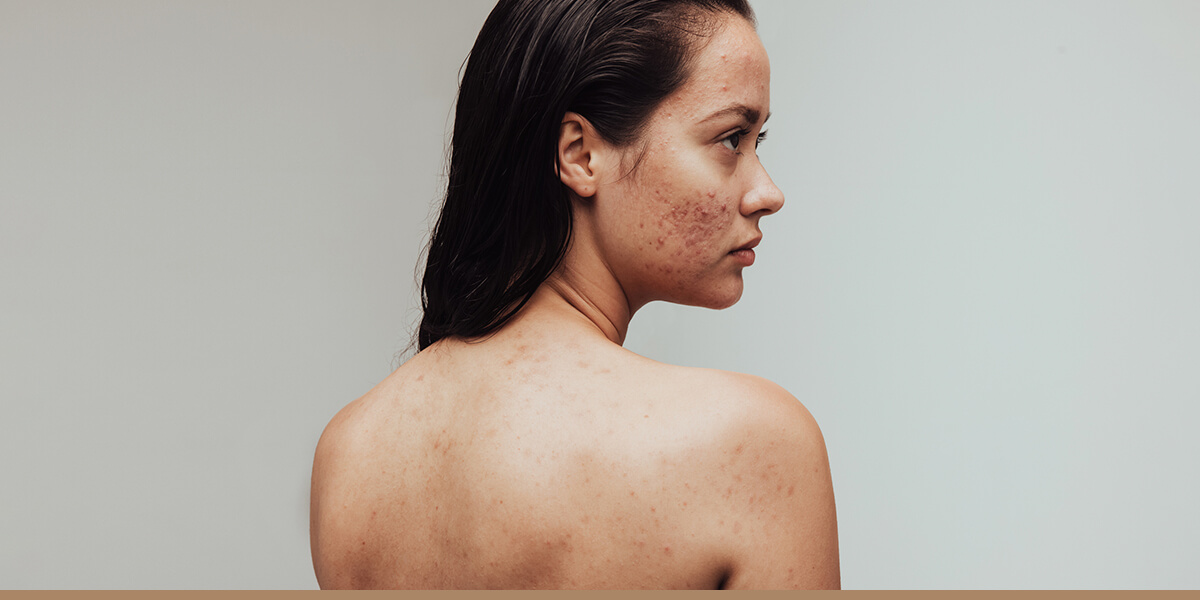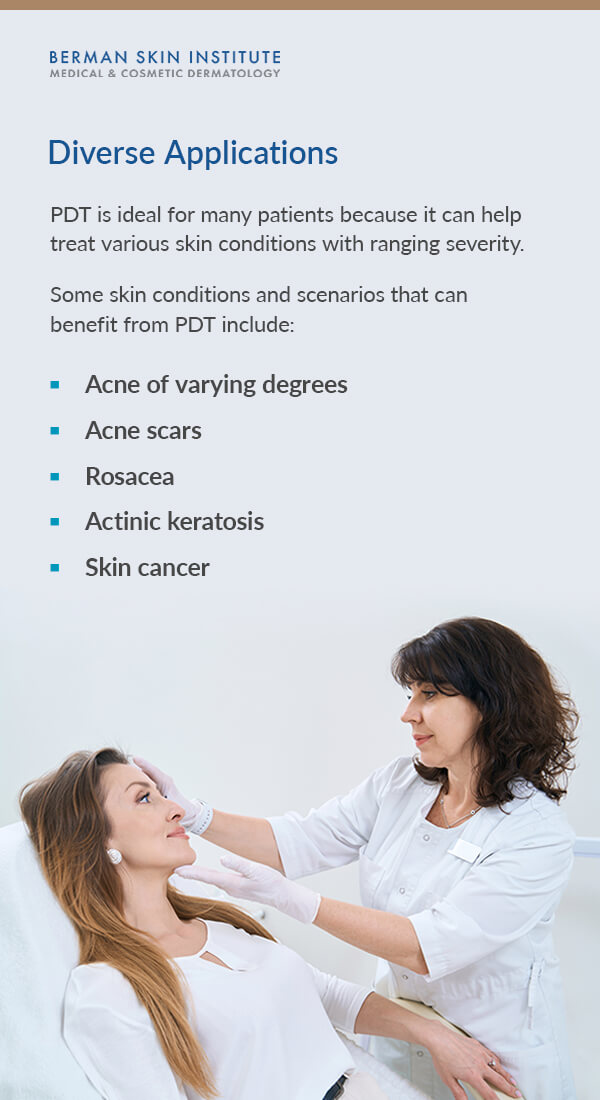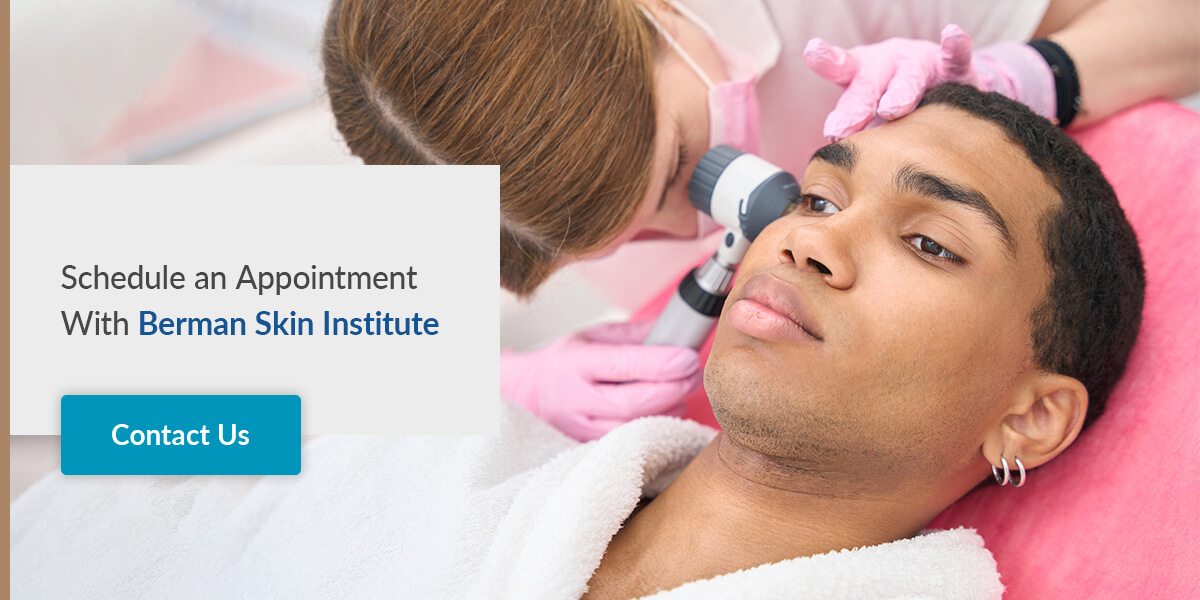
Photodynamic therapy is a versatile skincare treatment option that can be used to treat various skin conditions, including those that are resistant to other treatments. Understanding how photodynamic therapy works can help you determine if this treatment option is right for you.
What Is Photodynamic Therapy?
Photodynamic therapy (PDT) is a technique utilized in both cosmetic and medical dermatology. PDT uses a combination of light and a photosensitizing agent to alleviate a wide range of skin issues. The photosensitizing agent is an amino acid, typically Aminolevulinic acid, that penetrates deeply and reacts to light when oxygen is present, stimulating skin’s healing and regenerative factors.
During PDT, your provider will apply the topical photosensitizing solution to your skin. Only abnormal skin cells will react to the solution, producing molecules called porphyrins that will absorb light. This means Photodynamic Therapy only targets damaged or unhealthy skin cells for better results and more efficient care.
What to Expect During Photodynamic Therapy
If you are interested in Photodynamic Therapy, understanding the process can help you prepare beforehand and care for your skin afterward for optimal results. Because PDT can be customized to address a variety of skin conditions and symptoms, no two patients have the exact same experience. However, the general process remains the same. There are three main stages to Photodynamic Therapy treatment:
- Preparing the Skin: Avoid excessive sunlight for at least three days before your appointment. Your session will begin with microdermabrasion or a facial scrub to clear dirt, blackheads and dead skin from your skin’s surface. Then, your provider will apply the photosensitizing agent to your skin. The photosensitizing agent will require some time to soak into the skin, ranging from a period of a few minutes to a few hours.
- Photodynamic Therapy: When it’s time for treatment, your light therapy specialist use a medical light to activate the photosensitizing solution. In the presence of light and oxygen, the photosensitizing agent helps the light destroy acne-causing bacteria in the skin. The duration of the light treatment on your skin will also depend on your condition and the size of the affected area.
- Post-Treatment Care: During recovery it’s important to protect your skin. Before leaving, you should clear all other skin products with your provider to ensure they will work with your treatment and are unlikely to cause any adverse reactions. Like before appointments, you should avoid direct and excessive sunlight for three days to protect healing skin. Multiple photodynamic therapy sessions may be necessary to achieve optimal results.
Proper skin care before and after your PDT treatment is key to finding relief from your symptoms. Our team at Berman Skin Institute will provide you with all the information you need to protect your skin and help in the healing process.
6 Benefits of Photodynamic Therapy
When you are considering skincare treatment and methods, looking at the advantages of PDT can help determine if this option is right for you.
1. Diverse Applications

PDT is ideal for many patients because it can help treat various skin conditions with ranging severity. Because the treatment allows customization by case, your provider can adjust processes and techniques to serve you and your needs. Some skin conditions and scenarios that can benefit from PDT include:
- Acne of varying degrees: If you suffer from frequent and intense acne breakouts, you may benefit from PDT because of its ability to target acne directly. Your provider can use PDT to treat several types of acne, including mild, severe and cystic. The light decreases the size and activity of sebaceous glands, which produce oil in your skin. While these glands are essential for moisturizing the skin, overactivity and inflammation can lead to complications with acne. PDT addresses the root cause of this acne type for better results.
- Acne scars: PDT can also help fade acne scarring. Many people develop acne scars throughout their lifetime, but other treatments do little to reduce this type of discoloration. Because the photosensitizing agent targets abnormal skin cells directly, PDT can better address and reverse acne scars for clearer, smoother skin.
- Rosacea: Like with inflammatory acne types, PDT can also help with the inflammation that causes rosacea. PDT rosacea treatment can help you experience clearer skin with reduced oil production. It can also help minimize rhinophyma, or nose enlargement caused by inflammation.
- Actinic keratosis: Actinic keratosis are rough patches of scaly skin often caused by long-term sun exposure. PDT can target lesions to create a smoother, more cohesive skin texture. Because lesions can form across the body in various sizes, the flexibility of PDT allows providers to adjust the light size, type and therapy duration to treat lesions effectively.
- Skin cancer: Because PDT can effectively and efficiently target and destroy abnormal skin cells, many patients seek this treatment type for skin cancer. The Food and Drug Administration approved PDT to treat basal cell skin cancer and stage 0 squamous cell skin cancer.
PDT also benefits individuals who cannot seek out other acne treatment options. If you have allergies to ingredients in topical solutions or medications, you may be able to use this method to treat your acne or other skin conditions.
2. Non-Invasive
PDT benefits many patients because it’s non-invasive, instead using light and solutions to treat the skin rather than needles and scalpels. While some conditions might require you to undergo intensive surgeries or several sessions of acupuncture, PDT offers an alternative for optimized recovery and comfort.
3. Preventive Short-Term Treatment
If you have chronic conditions like acne, PDT can help manage symptoms and prevent them from appearing by addressing the cause. Because this treatment works well with inflammatory diseases, it can help reduce the oils and swelling that cause symptoms at the source rather than medications that aim to control and reduce the symptoms.
Know that PDT is not always a permanent solution. You might have to return for repeated sessions within a couple of weeks for continual results.
4. Less Drug Dependence
Antibiotics and other medications can be easy and effective for many people suffering from various skin conditions. However, bacteria can become resistant over time, causing drugs to no longer work. PDT offers an alternative treatment option without medication while effectively targeting bacteria and abnormal skin cells. If you have drug resistance or want to reduce medication use, this treatment option can help.
5. Better Skin Integrity After Treatment

PDT is a targeted skin treatment option that only affects the desired areas of the skin. While other treatment options might involve subjecting your skin to invasive procedures or irritating scrubs, PDT leaves most skin intact after treatment. This system can optimize healing processes by minimizing the area that must heal.
The result is often more cohesive skin texture and desired outcomes. When healthy skin can skip unnecessary treatment, it can stay healthy without disrupting the cells and glands maintaining its conditions. Unhealthy skin cells get the effective treatment they need to heal.
6. Compatible With Other Treatments
You can use PDT as a primary, supplementary or complimentary skincare treatment. While it’s very effective at treating various skin conditions, each person reacts differently to processes and techniques. You might even already have a skincare system you use, like topical solutions and medications. Some find that combination of treatment options yields the best results.
PDT can work alongside other treatments to match your needs. You can continue using some other medications, topical solutions and other skincare methods with PDT treatment. Be sure to let your physician know what skincare products you’re currently using.
Photodynamic Therapy FAQs
If you’re interested in PDT, you probably have questions about processes and recovery. Here are the answers to some common questions.
Are the Results Permanent?
The results of PDT are temporary solutions for most skin conditions. Much like medication, topical solutions and other care methods, PDT minimizes the symptoms and flares for various skin conditions. It’s not a cure. However, it can relieve symptoms for different lengths, allowing you to relax and enjoy yourself or forgo complicated and comprehensive skincare regimens required to maintain skin conditions.
Is Photodynamic Therapy Painful?
Most patients say that the pain from PDT is minimal, and overall, this is usually a painless procedure. Its non-invasive nature reduces the interaction with the skin and the amount of healing necessary. Because everyone has different pain tolerances, one person might feel more than another during and after treatment.
Patients usually describe mild to moderate stinging or burning during the light treatment portion of PDT. Others say the photosensitizing agent also caused some light to moderate stinging during pre-treatment phases.
What Are the Photodynamic Therapy Side Effects?
While PDT is often painless, it has some side effects that can impact your comfort levels during recovery and healing periods. After treatment, you might experience:
- Burning comparable to a mild sunburn
- Crusting
- Itching
- Swelling
- Tightening
- Redness
Peeling after photodynamic therapy is expected, much like with sunburns. You might also experience an acne flare-up after their PDT sessions. Side effects tend to be at their worst the first couple of days after sessions but will subside and clear by the end of the week.
How Long Is Treatment?

Treatment lengths will depend on your needs. If you have minimal facial acne, you’ll have shorter PDT sessions than if you have large lesions across your back. Pre-treatment needs will also impact appointment length. Some patients require longer periods for the photosensitizing agent to soak into their skin. While patients can go home overnight or for several days to wait for the agent to take effect, others might only have to sit for minutes or a couple of hours.
Going in for a consultation with our dermatologists can provide more clarity for your case.
How Frequently Do I Have to Return for Treatment?
Session frequency will involve two factors — how many sessions you will need to maintain your condition and how often you have to return. Both elements will depend on your conditions and reactions to treatment.
You might require multiple sessions to start condition management, with a couple of weeks between sessions. Or, you may have to come in more frequently. The time between sessions will also depend on how long your skin takes to heal from treatment.
How Much Does PDT Acne Treatment Cost?
Like other elements with PDT, cost varies greatly depending on your case. Prices can range from a couple hundred dollars per session to several thousand. Overall costs are on the higher end if you have to repeat sessions for optimal results.
Some factors that will determine the cost of PDT include:
- Condition coverage and severity
- Number of necessary sessions
- Area and local demand
- Individualized practitioner costs
- Insurance coverage
- Any specialized or additional services
Consultations with dermatologists can also help you find out if this treatment option is in your price range or if medical professionals offer financing or alternative payment solutions.
Will My Insurance Cover Photodynamic Therapy?
Coverage for PDT will vary depending on insurance plans and providers. However, many insurance providers will cover the cost of treatment if it’s deemed necessary. For example, if you have allergies to common acne treatment medications, you might get approval from your health insurance. Medicare also offers coverage for individuals who need this kind of skin treatment.
If you’re unsure, review your specific health care policy for included coverage and limitations. For any questions, contact your provider. Knowing what your insurance offers can prevent you from paying for expensive treatment out of pocket.
How Can I Support Healing After Treatment?
Because PDT uses photosensitizing agents to target skin conditions, light sensitivity will continue after treatment. In the week following sessions, you can promote healing by:
- Staying indoors: Avoiding direct contact with sunlight helps support your healing after PDT. Skin sensitivity to light can lead to burns and blisters that damage skin and undo treatment. You can better avoid sunlight by minimizing time outside.
- Covering impacted areas: When you have to go outdoors, you can protect your sensitive skin by dressing appropriately. Ensure all treated skin is well-covered with clothing to block the sun. You might wear sweaters, jackets or long pants and skirts, but coverage solutions will depend on where the treated skin is.
- Wearing a hat: If you have treated skin on your face or neck, a hat, sunglasses or other accessories can help shade the skin and keep it out of direct contact with the sun. Choose a wide-brimmed hat that offers more coverage to protect areas farther away from your face and block the sun at different angles.
Your physician will also offer more specific instructions on how to care for yourself after treatment. They will provide do’s and don’ts, so you can ensure you optimize your treatment and healing.
Schedule an Appointment With Berman Skin Institute
At Berman Skin Institute, we understand how much you care about your skin. Whether you want an alternative acne treatment or received a recent skin cancer diagnosis, we are here to help. Our technicians and physicians can guide you through PDT sessions to achieve the skincare results you want.
Located in northern California, we have several locations patients can visit to receive services. Contact Berman Skin Institute today to schedule an appointment and get started with PDT.







